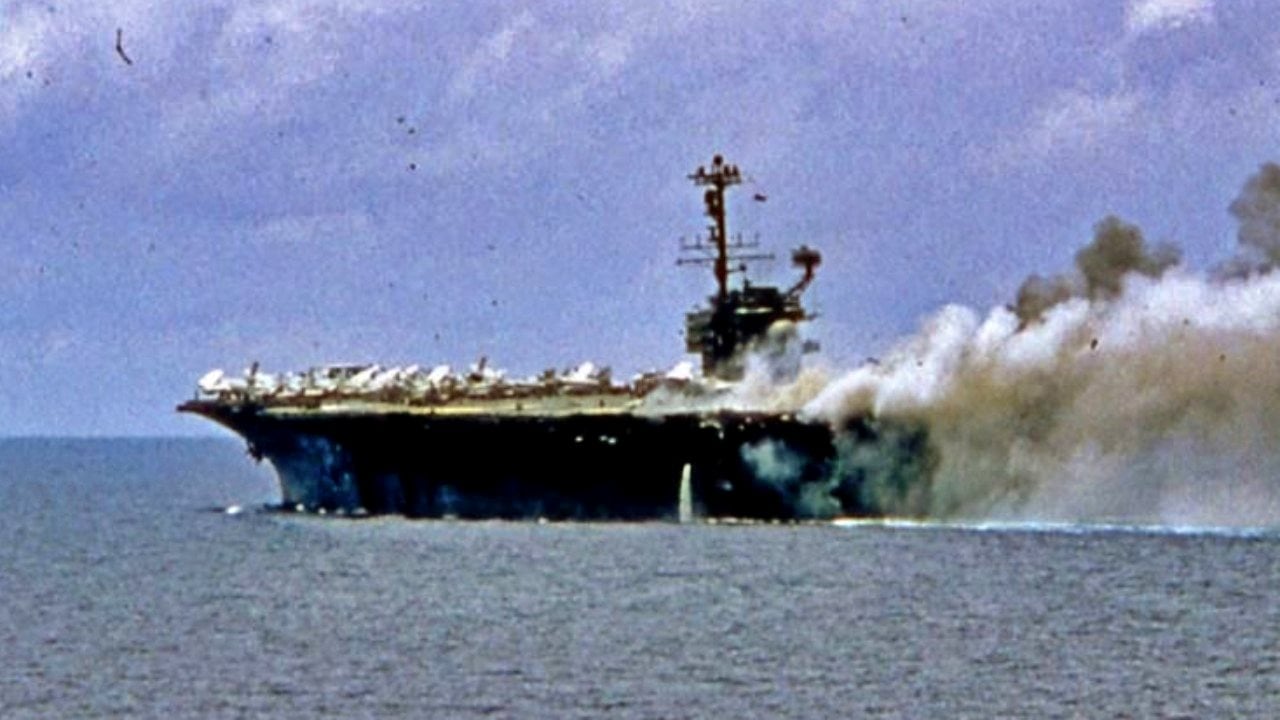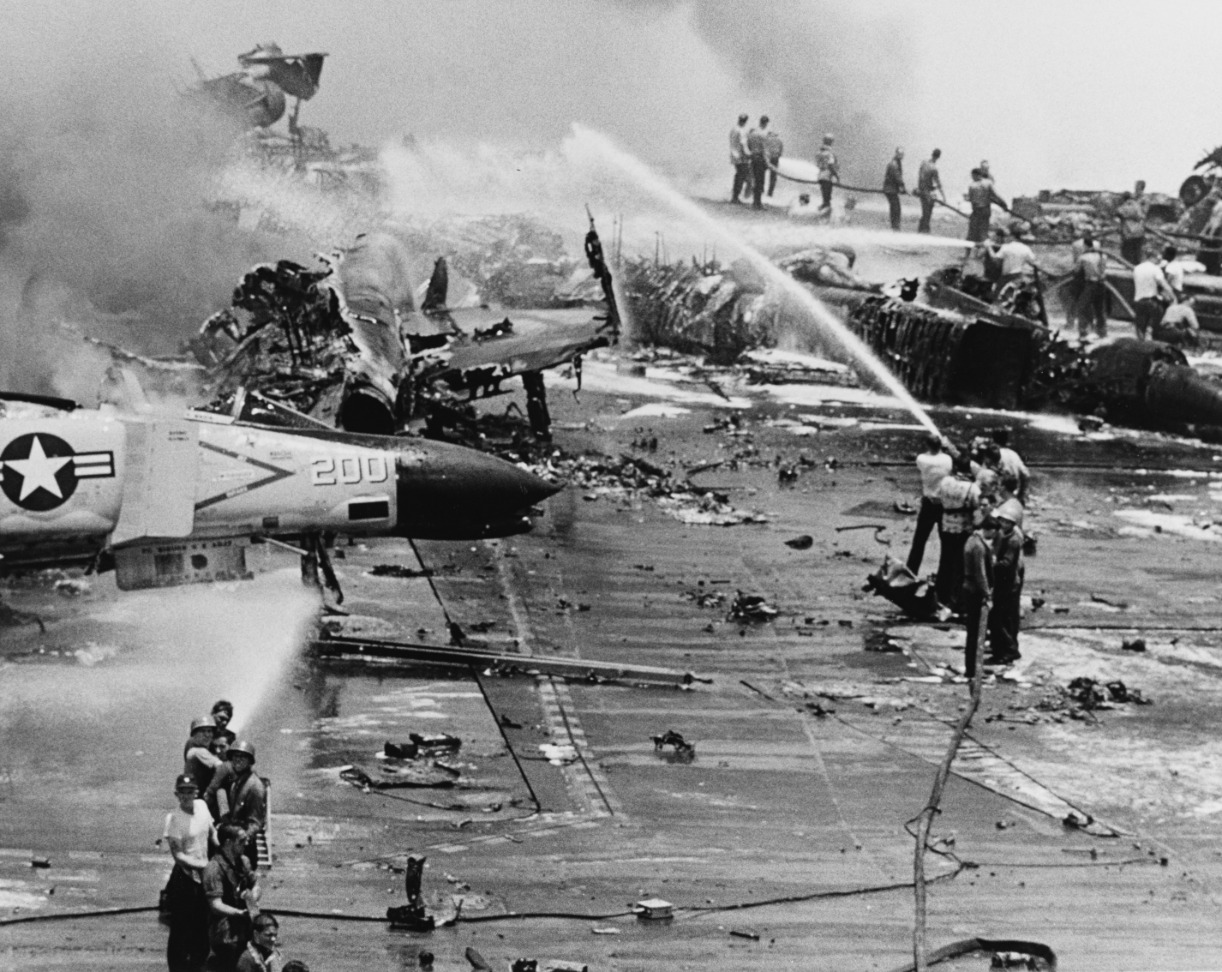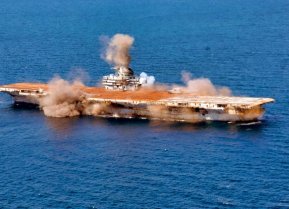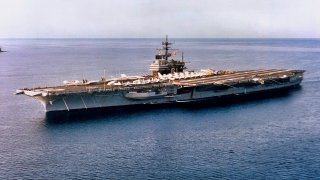Forrestal-Class: The Navy's First 'Supercarrier' Aircraft Carriers Were Special
The USS Midway, commissioned in 1945, boasted a massive complement of 130 combat aircraft, but it was the succeeding Forrestal-class that was the first true supercarrier, or big and powerful aircraft carrier.
The U.S. Navy's Forrestal-class aircraft carrier - an explainer : The Battle of Midway in 1942 cemented the role of the aircraft carrier as the premier naval warship.
Through the remainder of operations in the Pacific, carriers would prove their worth time and again. Military planners the world over took note of this and, in the decades following, endeavored to build ever greater carriers. In particular, the U.S., with its vested interest in maritime security, led the way in carrier development.
Angled flight decks, steam catapults, and optical landing systems all contributed to the growth of carriers through the years post-World War 2. The USS Midway, commissioned in 1945, boasted a massive complement of 130 combat aircraft, but it was the succeeding Forrestal-class that was the first true supercarrier, or big and powerful aircraft carrier.
Forrestal-class: Historic Warships
Not just any ship can be designated a supercarrier, and the Forrestal class truly earned that designation.
At over 1,000 feet long and displacing 81,000 tons fully loaded, these ships were truly behemoths of the ocean.
Their size was necessary as the advent of jet aviation had produced larger, faster aircraft that required more space for storage, launch, and recovery. While the preceding Midway-class had been adapted to serve this new type of airplane, the Forrestal boats were purpose-built with jet aircraft in mind.
In addition to their size, these ships drew on many lessons from the Midway-class before them. In particular, those boats had been known for faring poorly in rough weather. Their low freeboard and heavy flight deck made them prone to rolling and taking on water in heavy seas. The Forrestals countered this in several ways.
Previous carriers had been designed with the hangar deck as the strength - or structural - deck while the flight deck was technically part of the superstructure. In essence, they were large ships with a flight deck placed on top. This added weight up high contributed to their instability. On the Forrestal-class, the flight deck was the strength deck; it was an essential part to keep the ship together. This design change required a larger and deeper hull, which made for a more stable platform with greater height above the water, vastly improving their performance in bad weather.

In addition, the design forced the incorporation of a hurricane bow, which fully enclosed the forward part of the ship. The Midway ships, and all aircraft carriers before them, had a gap between the flight deck and the structure of the ship up forward. While this was convenient for emplacing anti-aircraft guns, it also made these ships highly prone to taking on seawater when plunging into the waves.
While these ships used lessons learned from prior designs to build a better carrier, they also suffered from several defects that would influence future vessels. Notably, the port-side aircraft elevator was placed in front of the waist catapults, which made its use impossible while the waist catapults were launching aircraft. The placement of the starboard side elevators also made aircraft handling between the hangar and the flight deck challenging. Both issues were rectified on later ships.
Arguably, the biggest contribution came from the USS Forrestal - lead ship in class - on her most tragic day, and indeed the deadliest day for the U.S. Navy since the Second World War.
The USS Forrestal Fire
In the summer of 1967, the USS Forrestal was operating at Yankee Station, a famous point in the Gulf of Tonkin at which carriers operated throughout the Vietnam War. She had been conducting combat operations for four days when, on July 29th, a series of cascading failures would lead to a catastrophic fire that would take the lives of 134 sailors and injure a further 161. The aftermath of the disaster and the following investigations continue to shape the U.S. Navy practice to this day.
As the Vietnam War ramped up, the Navy carried out a sustained bombing campaign at a far greater scale than it ever had previously. Throughout the campaign, stockpiles of bombs began to run critically low. In particular, the Navy’s new Mk 84 1,000lb bombs. These munitions used the explosive H6, a stable compound that could theoretically withstand up to ten minutes of heat from a fire before detonating. Additionally, this compound was more likely to deflagrate or produce a low-order detonation should the heat trigger an explosion.
To make up for a shortcoming in Mk 83s, the Navy began pulling older and older ordnance out of storage. The day before the fire, the Forrestal received 16 AN-M65A1 1,000lb bombs. These weapons used Composition B as their explosive charge, which was far more unstable and prone to sympathetic detonations. Furthermore, several had been manufactured as early as 1953 and stored in abysmal conditions since then, causing them to be highly degraded. Personnel on the carrier feared even handling them, let alone using them, and some wondered if they would detonate simply from the force of a catapult launch. Nevertheless, they were needed for the war, and so were accepted and loaded onto aircraft.
The Spark
In addition to 1,000lb bombs, ground attack aircraft serving in Vietnam were also often equipped with Mk-32 “Zuni'' unguided rockets. These rockets were known to have several defects. They were secured from accidental discharge by a safety pin with an attached flag. In high winds such as those found on a flight deck, this pin could be blown free.
Standard operating procedure (SOP) aboard the carrier dictated that the electronic pigtail attached to the LAU-10 rocket launchers, which held the Zunis, was not to be connected until the aircraft was on the catapult, ready for launch. Shipboard officers had found that this often delayed launches and so modified the procedure to allow crewmembers to attach the plug while the aircraft was still awaiting taxi to the catapult.
The Fire
In the late morning, as the carrier prepared to launch the second combat sortie, the necessary pieces aligned, and disaster struck. A Zuni rocket loaded on an F-4 Phantom on the starboard fantail launched across the flight deck and struck the fuel tank of a fully loaded A-4 Skyhawk parked on the port side of the flight deck.

While the safety mechanism within the rocket prevented it from exploding, the resulting fuel spill swiftly ignited, and fire began to spread among the A-4s. Chief Gerald Farrier, head of the Number 8 Damage Control team, leaped into action and began dousing the M65A1 bombs strapped to the A-4 with fire-suppressing foam. As his team rushed in to help, the first of the faulty bombs detonated in a massive explosion that tore a hole in the flight deck and killed most of the firefighting crew, including Chief Farrier.
From there, the fire rapidly began spiraling out of control. Burning fuel poured through holes in the flight deck as other defective M65A1s began to detonate, causing further catastrophic damage. The Forrestal’s crew, most of whom did not have firefighting training, did their utmost to contain the blaze while the destroyer USS Rupertus sailed within 20 feet of the Forrestal to allow her firefighting hoses to tackle the blaze. After 14 hours of heroic effort, the fires were finally controlled, although teams would spend another 16 hours tackling hotspots and cooling spaces.

The aftermath of the deadly fire
The U.S. Navy swiftly convened a panel to investigate the disaster. Initial theories directed the investigation toward the pilots of A-4s, suspecting some type of engine fire on startup had begun the disaster.
Fine attention to detail in camera footage of the flight deck, however, caused the investigation to realize the true culprit soon. From there, they worked out the change in SOP and atrocious ordnance that led to the magnitude of the disaster.
One of the major conclusions of the report was to update the Navy’s shipboard damage control training and processes. During the Second World War, the Navy focused on training nearly every sailor on at least the rudimentaries of firefighting. By 1967, however, this model had been abandoned in favor of specialized damage control teams. The Forrestal fire exposed the dangers of this approach. It led to the establishment of the Farrier Firefighting School in Norfolk and mandatory damage control training for all sailors in the Navy.
Another of the committee’s findings was that while several of the crew had correctly sprayed the fire down with foam suppressant, other members, untrained and unaware, had begun spraying down the deck with seawater. This had the deleterious effect of both rinsing off the firefighting foam as well as washing burning fuel into the spaces below through holes in the flight deck. In response, the Navy installed a washdown system to spray foam or water onto the flight deck. This system was installed on the USS John F. Kennedy, which was then under construction and was used to great effect by the USS Ronald Reagan during Operation Tomodachi in response to the Fukushima Nuclear Disaster to rinse potential radiation hazards from the flight deck.


